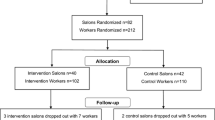Abstract
In recent decades, the nail salon industry has been one of the fastest growing in the U.S. California has over 300,000 workers licensed to perform nail care services. Though little is known about their health, these workers routinely handle cosmetic products containing carcinogens and endocrine disruptors that may increase a woman’s breast cancer risk. Additionally, an estimated 59–80% of California nail salons are run by Vietnamese women who face socio-cultural barriers that may compromise their workplace safety and health care access. In a pilot project designed to characterize Vietnamese nail salon workers in Alameda County, California in order to inform future health interventions and reduce occupational exposures, we conducted face-to-face surveys with a convenience sample of 201 Vietnamese nail salon workers at 74 salons. Of the workers surveyed, a majority reported that they are concerned about their health from exposure to workplace chemicals. Additionally, a sizeable proportion reported having experienced some health problem after they began working in the industry, particularly acute health problems that may be associated with solvent exposure (e.g. skin and eye irritation, breathing difficulties and headaches). Our findings highlight a critical need for further investigation into the breast cancer risk of nail salon workers, underscored by the workers’ routine use of carcinogenic and endocrine-disrupting chemicals, their prevalent health concerns about such chemicals, and their high level of acute health problems. Moreover, the predominance of Vietnamese immigrant women in this workforce makes it an important target group for further research and health interventions.


Similar content being viewed by others
References
National Institute for Occupational Safety and Health (NIOSH). (2006). Registry of toxic effects of chemical substances (RTECS) [web page]. Available at http://www.cdc.gov/niosh/rtecs/default.html. Accessed 6 Feb 2007.
Brody, J. G., & Rudel, R. A. (2003). Environmental pollutants and breast cancer. Environmental Health Perspectives, 111, 1007–1119.
Rudel, R. A., Attfield, K. R., Schifano, J. N., & Brody, J. G. (2007). Chemicals causing mammary gland tumors in animals signal new directions for epidemiology, chemicals testing, and risk assessment for breast cancer prevention. Cancer, 109, 2635–2666.
Roelofs, C., Azaroff, L. S., Holcroft, C., Nguyen, H., & Doan, T. (2007). Results from a community-based occupational health survey of Vietnamese-American nail salon workers. Journal of Immigrant and Minority Health, Epub ahead of print.
Health Evaluation System, Information Service (HESIS). (1995). Toluene. Richmond, CA, USA: State of California, Occupational Health Branch.
World Health Organization (WHO), International Agency for Research on Cancer (IARC). (1982). IARC monographs on the evaluation of carcinogenic risks to humans: Vol. 29: Some industrial chemicals and dyestuffs. Lyon, France: World Health Organization (WHO).
Agency for Toxic Substances Disease Registry (ATSDR). (2006). Toxicological profile information sheet [web page]. Available at http://www.atsdr.cdc.gov/toxpro2.html. Accessed 6 Feb 2007.
Federman, M. N., Harrington, D. E., & Krynski, K. J. (2006). Vietnamese manicurists: Are immigrants displacing natives or finding new nails to polish? Industrial & Labor Relations Review, 59, 302–318.
NAILS. (2006). 2006 Nail technician demographics. Nails Magazine 2005–2006 Big Book. Torrance, CA, USA: NAILS.
Ly, M., Tufts University. (2003). Assessing and communicating occupational health risks to Vietnamese nail salon workers (honors thesis). Medford, MA, USA: Tufts University.
California State Board of Barbering, Cosmetology (BBC). (2006). Application for examination. Sacramento, CA, USA: California State Board of Barbering and Cosmetology.
United States Census Bureau. (2002). Census 2000 profile: California. Washington, DC, USA: United States Department of Commerce, Economics and Statistics Administration.
Mock, J., Nguyen, T., Nguyen, K. H., Bui-Tong, N., & McPhee, S. J. (2006). Processes and capacity-building benefits of lay health worker outreach focused on preventing cervical cancer among Vietnamese. Health Promotion Practice, 7, 223S–232S.
American Society of Heating, Refrigerating and Air-Conditioning Engineers (ASHRAE). (2007). Standard 62.1-2007: Ventilation for acceptable indoor air quality. Atlanta, GA, USA: American Society of Heating, Refrigerating and Air-Conditioning Engineers (ASHRAE).
California Health Interview Survey (CHIS). (2007). Public use files (custom data analysis) [Web Page]. Available at http://www.chis.ucla.edu/main/default.asp?page=puf. Accessed 6 Feb 2007.
Perkins, C. I., Wright, W. E., Allen, M., Samuels, S. J, & Romano, P. S. (2001). Breast cancer stage at diagnosis in relation to duration of Medicaid enrollment. Medical Care, 39, 1224–1233.
Nguyen, T., Vo, P. H., McPhee, S. J., & Jenkins, C. N. (2001). Promoting early detection of breast cancer among Vietnamese-American women. Results of a controlled trial. Cancer, 91, 267–273.
Nguyen, B. H., Vo, P. H., Doan, H. T., & McPhee, S. J. (2006). Using focus groups to develop interventions to promote colorectal cancer screening among Vietnamese Americans. Journal of Cancer Education, 21, 80–83.
LoSasso, G. L., Rapport, L. J., Axelrod, B. N., & Whitman, R. D. (2002). Neurocognitive sequelae of exposure to organic solvents and (meth)acrylates among nail-studio technicians. Neuropsychiatry, Neuropsychology, and Behavioral Neurology, 15, 44–55.
LoSasso, G. L., Rapport, L. J., & Axelrod, B. N. (2001). Neuropsychological symptoms associated with low-level exposure to solvents and (meth)acrylates among nail technicians. Neuropsychiatry, Neuropsychology, and Behavioral Neurology, 14, 183–189.
Spencer, A. B., Estill, C. F., McCammon, J. B., Mickelsen, R. L., & Johnson, O. E. (1997). Control of ethyl methacrylate exposures during the application of artificial fingernails. American Industrial Hygiene Association Journal, 58, 214–218.
Wright, C., & Quint, J. (1989). Analysis of pregnancy-related calls to an occupational hazard hot line. The Western Journal of Medicine, 151, 670–675.
NAILS Magazine. (2007). First study of Vietnamese salon industry proves some stereotypes, debunks others. NAILS Magazine, March, 76–88.
Author information
Authors and Affiliations
Corresponding author
Rights and permissions
About this article
Cite this article
Quach, T., Nguyen, KD., Doan-Billings, PA. et al. A Preliminary Survey of Vietnamese Nail Salon Workers in Alameda County, California. J Community Health 33, 336–343 (2008). https://doi.org/10.1007/s10900-008-9107-7
Published:
Issue Date:
DOI: https://doi.org/10.1007/s10900-008-9107-7




